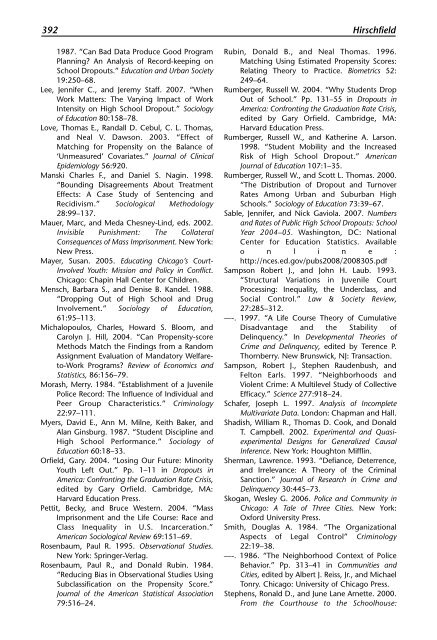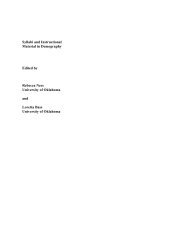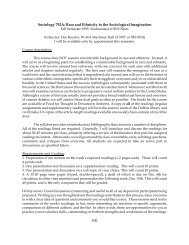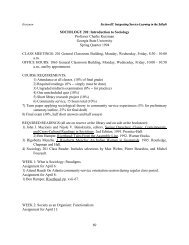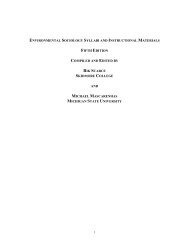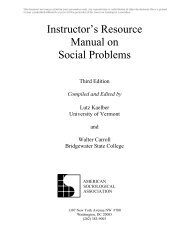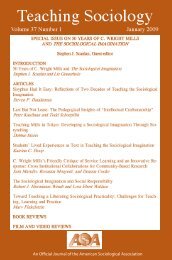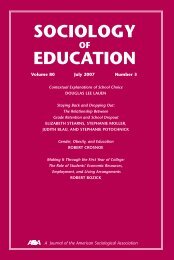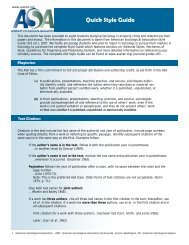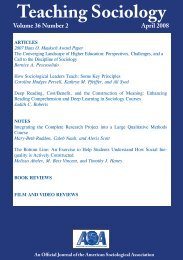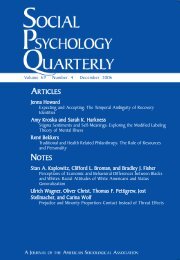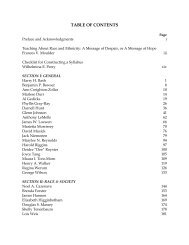SOCIOLOGY EDUCATION - American Sociological Association
SOCIOLOGY EDUCATION - American Sociological Association
SOCIOLOGY EDUCATION - American Sociological Association
Create successful ePaper yourself
Turn your PDF publications into a flip-book with our unique Google optimized e-Paper software.
392 Hirschfield<br />
1987. “Can Bad Data Produce Good Program<br />
Planning? An Analysis of Record-keeping on<br />
School Dropouts.” Education and Urban Society<br />
19:250–68.<br />
Lee, Jennifer C., and Jeremy Staff. 2007. “When<br />
Work Matters: The Varying Impact of Work<br />
Intensity on High School Dropout.” Sociology<br />
of Education 80:158–78.<br />
Love, Thomas E., Randall D. Cebul, C. L. Thomas,<br />
and Neal V. Dawson. 2003. “Effect of<br />
Matching for Propensity on the Balance of<br />
‘Unmeasured’ Covariates.” Journal of Clinical<br />
Epidemiology 56:920.<br />
Manski Charles F., and Daniel S. Nagin. 1998.<br />
“Bounding Disagreements About Treatment<br />
Effects: A Case Study of Sentencing and<br />
Recidivism.” <strong>Sociological</strong> Methodology<br />
28:99–137.<br />
Mauer, Marc, and Meda Chesney-Lind, eds. 2002.<br />
Invisible Punishment: The Collateral<br />
Consequences of Mass Imprisonment. New York:<br />
New Press.<br />
Mayer, Susan. 2005. Educating Chicago’s Court-<br />
Involved Youth: Mission and Policy in Conflict.<br />
Chicago: Chapin Hall Center for Children.<br />
Mensch, Barbara S., and Denise B. Kandel. 1988.<br />
“Dropping Out of High School and Drug<br />
Involvement.” Sociology of Education,<br />
61:95–113.<br />
Michalopoulos, Charles, Howard S. Bloom, and<br />
Carolyn J. Hill, 2004. “Can Propensity-score<br />
Methods Match the Findings from a Random<br />
Assignment Evaluation of Mandatory Welfareto-Work<br />
Programs? Review of Economics and<br />
Statistics, 86:156–79.<br />
Morash, Merry. 1984. “Establishment of a Juvenile<br />
Police Record: The Influence of Individual and<br />
Peer Group Characteristics.” Criminology<br />
22:97–111.<br />
Myers, David E., Ann M. Milne, Keith Baker, and<br />
Alan Ginsburg. 1987. “Student Discipline and<br />
High School Performance.” Sociology of<br />
Education 60:18–33.<br />
Orfield, Gary. 2004. “Losing Our Future: Minority<br />
Youth Left Out.” Pp. 1–11 in Dropouts in<br />
America: Confronting the Graduation Rate Crisis,<br />
edited by Gary Orfield. Cambridge, MA:<br />
Harvard Education Press.<br />
Pettit, Becky, and Bruce Western. 2004. “Mass<br />
Imprisonment and the Life Course: Race and<br />
Class Inequality in U.S. Incarceration.”<br />
<strong>American</strong> <strong>Sociological</strong> Review 69:151–69.<br />
Rosenbaum, Paul R. 1995. Observational Studies.<br />
New York: Springer-Verlag.<br />
Rosenbaum, Paul R., and Donald Rubin. 1984.<br />
“Reducing Bias in Observational Studies Using<br />
Subclassification on the Propensity Score.”<br />
Journal of the <strong>American</strong> Statistical <strong>Association</strong><br />
79:516–24.<br />
Rubin, Donald B., and Neal Thomas. 1996.<br />
Matching Using Estimated Propensity Scores:<br />
Relating Theory to Practice. Biometrics 52:<br />
249–64.<br />
Rumberger, Russell W. 2004. “Why Students Drop<br />
Out of School.” Pp. 131–55 in Dropouts in<br />
America: Confronting the Graduation Rate Crisis,<br />
edited by Gary Orfield. Cambridge, MA:<br />
Harvard Education Press.<br />
Rumberger, Russell W., and Katherine A. Larson.<br />
1998. “Student Mobility and the Increased<br />
Risk of High School Dropout.” <strong>American</strong><br />
Journal of Education 107:1–35.<br />
Rumberger, Russell W., and Scott L. Thomas. 2000.<br />
“The Distribution of Dropout and Turnover<br />
Rates Among Urban and Suburban High<br />
Schools.” Sociology of Education 73:39–67.<br />
Sable, Jennifer, and Nick Gaviola. 2007. Numbers<br />
and Rates of Public High School Dropouts: School<br />
Year 2004–05. Washington, DC: National<br />
Center for Education Statistics. Available<br />
o n l i n e :<br />
http://nces.ed.gov/pubs2008/2008305.pdf<br />
Sampson Robert J., and John H. Laub. 1993.<br />
“Structural Variations in Juvenile Court<br />
Processing: Inequality, the Underclass, and<br />
Social Control.” Law & Society Review,<br />
27:285–312.<br />
—-. 1997. “A Life Course Theory of Cumulative<br />
Disadvantage and the Stability of<br />
Delinquency.” In Developmental Theories of<br />
Crime and Delinquency, edited by Terence P.<br />
Thornberry. New Brunswick, NJ: Transaction.<br />
Sampson, Robert J., Stephen Raudenbush, and<br />
Felton Earls. 1997. “Neighborhoods and<br />
Violent Crime: A Multilevel Study of Collective<br />
Efficacy.” Science 277:918–24.<br />
Schafer, Joseph L. 1997. Analysis of Incomplete<br />
Multivariate Data. London: Chapman and Hall.<br />
Shadish, William R., Thomas D. Cook, and Donald<br />
T. Campbell. 2002. Experimental and Quasiexperimental<br />
Designs for Generalized Causal<br />
Inference. New York: Houghton Mifflin.<br />
Sherman, Lawrence. 1993. “Defiance, Deterrence,<br />
and Irrelevance: A Theory of the Criminal<br />
Sanction.” Journal of Research in Crime and<br />
Delinquency 30:445–73.<br />
Skogan, Wesley G. 2006. Police and Community in<br />
Chicago: A Tale of Three Cities. New York:<br />
Oxford University Press.<br />
Smith, Douglas A. 1984. “The Organizational<br />
Aspects of Legal Control” Criminology<br />
22:19–38.<br />
—-. 1986. “The Neighborhood Context of Police<br />
Behavior.” Pp. 313–41 in Communities and<br />
Cities, edited by Albert J. Reiss, Jr., and Michael<br />
Tonry. Chicago: University of Chicago Press.<br />
Stephens, Ronald D., and June Lane Arnette. 2000.<br />
From the Courthouse to the Schoolhouse:


